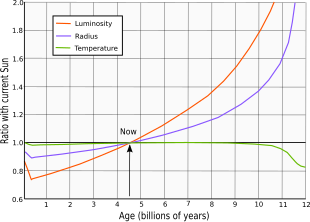Solar radius

Multi tool use
| 1 R☉ = |
Units |
|---|---|
| 7008695700000000000♠6.95700×108 | metres |
| 695,700 | kilometres |
| 0.00465047 | astronomical unit |
| 432,288 | miles |
| 6992735355000000000♠7.35355×10−8 | light-year |
| 6992225461000000000♠2.25461×10−8 | parsec |
| 2.32061 | light-seconds |
Solar radius is a unit of distance used to express the size of stars in astronomy relative to the Sun. The solar radius is usually defined as the radius to the layer in the Sun's photosphere where the optical depth equals 2/3:
- 1R⊙=6.957×105 km{displaystyle 1,R_{odot }=6.957times 10^{5}{hbox{ km}}}
695,700 kilometres (432,300 miles) is approximately 10 times the average radius of Jupiter, about 109 times the radius of the Earth, and 1/215th of an astronomical unit, the distance of the Earth from the Sun. It varies slightly from pole to equator due to its rotation, which induces an oblateness in the order of 10 parts per million.[1]
Contents
1 Measurements
2 Nominal solar radius
3 Examples
4 See also
5 References
6 External links
Measurements

Evolution of the solar luminosity, radius and effective temperature compared to the present-day Sun. After Ribas (2010)[2]
The unmanned SOHO spacecraft was used to measure the radius of the Sun by timing transits of Mercury across the surface during 2003 and 2006. The result was a measured radius of 696,342 ± 65 kilometres (432,687 ± 40 miles).[3]
Haberreiter, Schmutz & Kosovichev (2008)[4] determined the radius corresponding to the solar photosphere to be 695,660 ± 140 kilometres (432,263 ± 87 miles). This new value is consistent with helioseismic estimates; the same study showed that previous estimates using inflection point methods had been overestimated by approximately 300 km (190 mi).
Nominal solar radius
In 2015, the International Astronomical Union passed Resolution B3, which defined a set of nominal conversion constants for stellar and planetary astronomy. Resolution B3 defined the nominal solar radius (symbol R⊙N{displaystyle R_{odot }^{N}}
Examples
Solar radii as a unit are popular when talking about spacecraft moving close to the sun. Two spacecraft in the 2010s.
Solar Orbiter (as close as 45 Solar radii, Rs)
Parker Solar Probe (as close as 9 Solar radii, Rs)
See also
- Astronomical unit
- Orders of magnitude (length)
- Solar luminosity
- Solar mass
References
^ NASA RHESSI oblateness measurements 2012
^ Ribas, Ignasi (February 2010), "Solar and Stellar Variability: Impact on Earth and Planets, Proceedings of the International Astronomical Union, IAU Symposium", Solar and Stellar Variability: Impact on Earth and Planets, 264: 3–18, arXiv:0911.4872, Bibcode:2010IAUS..264....3R, doi:10.1017/S1743921309992298|contribution=ignored (help).mw-parser-output cite.citation{font-style:inherit}.mw-parser-output .citation q{quotes:"""""""'""'"}.mw-parser-output .citation .cs1-lock-free a{background:url("//upload.wikimedia.org/wikipedia/commons/thumb/6/65/Lock-green.svg/9px-Lock-green.svg.png")no-repeat;background-position:right .1em center}.mw-parser-output .citation .cs1-lock-limited a,.mw-parser-output .citation .cs1-lock-registration a{background:url("//upload.wikimedia.org/wikipedia/commons/thumb/d/d6/Lock-gray-alt-2.svg/9px-Lock-gray-alt-2.svg.png")no-repeat;background-position:right .1em center}.mw-parser-output .citation .cs1-lock-subscription a{background:url("//upload.wikimedia.org/wikipedia/commons/thumb/a/aa/Lock-red-alt-2.svg/9px-Lock-red-alt-2.svg.png")no-repeat;background-position:right .1em center}.mw-parser-output .cs1-subscription,.mw-parser-output .cs1-registration{color:#555}.mw-parser-output .cs1-subscription span,.mw-parser-output .cs1-registration span{border-bottom:1px dotted;cursor:help}.mw-parser-output .cs1-ws-icon a{background:url("//upload.wikimedia.org/wikipedia/commons/thumb/4/4c/Wikisource-logo.svg/12px-Wikisource-logo.svg.png")no-repeat;background-position:right .1em center}.mw-parser-output code.cs1-code{color:inherit;background:inherit;border:inherit;padding:inherit}.mw-parser-output .cs1-hidden-error{display:none;font-size:100%}.mw-parser-output .cs1-visible-error{font-size:100%}.mw-parser-output .cs1-maint{display:none;color:#33aa33;margin-left:0.3em}.mw-parser-output .cs1-subscription,.mw-parser-output .cs1-registration,.mw-parser-output .cs1-format{font-size:95%}.mw-parser-output .cs1-kern-left,.mw-parser-output .cs1-kern-wl-left{padding-left:0.2em}.mw-parser-output .cs1-kern-right,.mw-parser-output .cs1-kern-wl-right{padding-right:0.2em}
^ Emilio, Marcelo; Kuhn, Jeff R.; Bush, Rock I.; Scholl, Isabelle F. (2012), "Measuring the Solar Radius from Space during the 2003 and 2006 Mercury Transits", The Astrophysical Journal, 750 (2): 135, arXiv:1203.4898, Bibcode:2012ApJ...750..135E, doi:10.1088/0004-637X/750/2/135
^ Haberreiter, M; Schmutz, W; Kosovichev, A.G. (2008), "Solving the Discrepancy between the Seismic and Photospheric Solar Radius", Astrophysical Journal, 675 (1): L53–L56, arXiv:0711.2392, Bibcode:2008ApJ...675L..53H, doi:10.1086/529492
^ Mamajek, E.E.; Prsa, A.; Torres, G.; et, al. (2015), IAU 2015 Resolution B3 on Recommended Nominal Conversion Constants for Selected Solar and Planetary Properties, arXiv:1510.07674, Bibcode:2015arXiv151007674M
External links
S. C. Tripathy; H. M. Antia (1999). "Influence of surface layers on the seismic estimate of the solar radius". Solar Physics. 186 (1/2): 1–11. Bibcode:1999SoPh..186....1T. doi:10.1023/A:1005116830445.
T. M. Brown; J. Christensen-Dalsgaard (1998). "Accurate Determination of the Solar Photospheric Radius". Astrophysical Journal Letters. 500 (2): L195. arXiv:astro-ph/9803131. Bibcode:1998ApJ...500L.195B. doi:10.1086/311416.
yfaxc leortYVD34fUvk,r,lD4PyoHYrRDEtlam4Wnt8AMJ40Wgq8 doQhGchYsxpTLpZlAxh5 nedzkHim46pZBv
